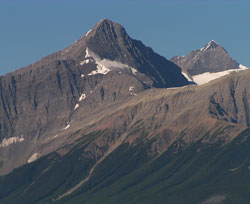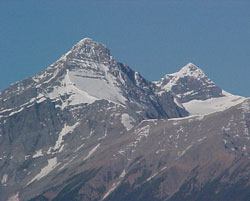
Photo: Looking southwest to Mount Outram from Saskatchwan River Crossing
Mount Outram
- 3240 m (10,630ft)
- First Ascent
- Naming History
Located above the confluence of Glacier River and Howse River, 4.5 km northeast of Mount Forbes
Province: Alberta
Park: Banff
Headwater: Saskatchewan
Visible from Highway: 93N
Ascent Party: F.V. Field, W.O. Field, L. Harris
Ascent Guide: Edward Feuz jr., J. Biner
Named for: Outram, James (James Outram was an early climber in the Canadian Rockies whose first ascents included Mount Assiniboine and Mount Columbia.)
When viewed from Saskatchewan River Crossing, Mount Outram features near vertical cliffs on its north-eastern face, below which lies a large, square patch of snow which persists into the fall. To the left of Mount Outram lies the valley of the Howse River and to its right, the valley which contains the largest lake in Banff National Park, Glacier Lake. In his drive to make the first ascents of high mountains, James Outram was probably the most ambitious of the early climbers to visit the Canadian Rockies. He was a British Clergyman who had been the vicar of St. Peter's Anglican Church at Ipswich and had had experience climbing in the Alps. Outram's focus on first ascents was made clear when he wrote that the mountaineer's soul, "will crave- and rightly so- the chief joy of the climber's ambition, a 'first ascent'." This unabashed competitive urge brought him into conflict with some of the other early mountaineers. Norman Collie referred to him as an "interloper" and wrote that some of the climbers who had done the early exploration of an area should, "get some of the scalps." Outram's twenty-eight first ascents were concentrated into the years 1901 and 1902. One of the most notable was Mount Assiniboine in September, 1901. Many of the high mountains he climbed were in the headwaters of the North Saskatchewan River where Outram was able to take advantage of Norman Collie's preliminary explorations of 1898. During the summer of 1902, together with his guide Christian Kaufmann and outfitters Jimmy Simpson and Fred Ballard, he completed the first ascents of ten peaks exceeding 10 000 feet during the fifty-four day outing. An incident during this trip resulted in Jimmy Simpson recalling later that, "Outram wanted all the glory himself," and that he treated Kaufmann as, "just help." Simpson had accompanied Outram and Kaufman on a long, late day hike to reconnoiter Mount Columbia, which with an elevation of 3747 metres, is the highest peak in Alberta. When a promising route was discovered, Jimmie became quite excited about the climb which was planned for the next day and asked if he could accompany Outram to the summit but his request was refused. Outram and Kaufman left camp at 1:00 a.m. the following morning and eleven hours later, "planted the Union Jack upon the broad white platform which crowns the summit of the highest point so far occupied in Canada." They returned to camp at 11:00 p.m., completing their twenty-two hour day. Outram spent his remaining years in Canada, having found, "in the lonely woods or on the solitary mountain tops of Canada, the long-sought sanctuary of the storm-tossed soul. There, burdens that seemed too heavy to be borne are rolled away."





